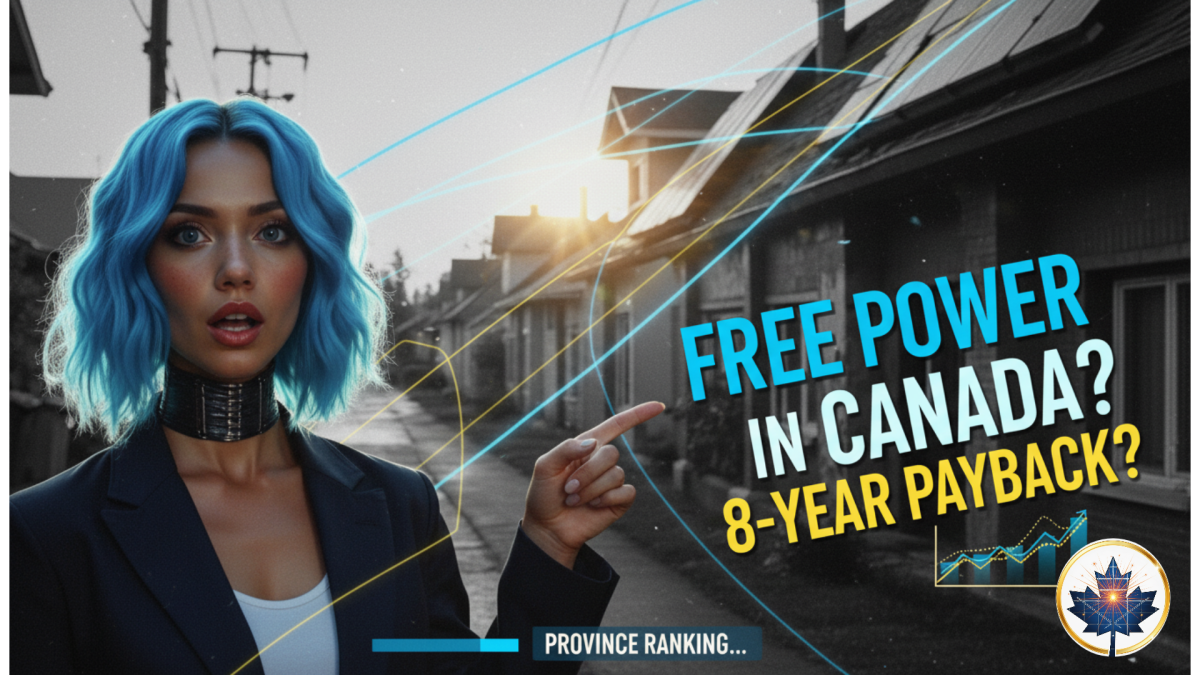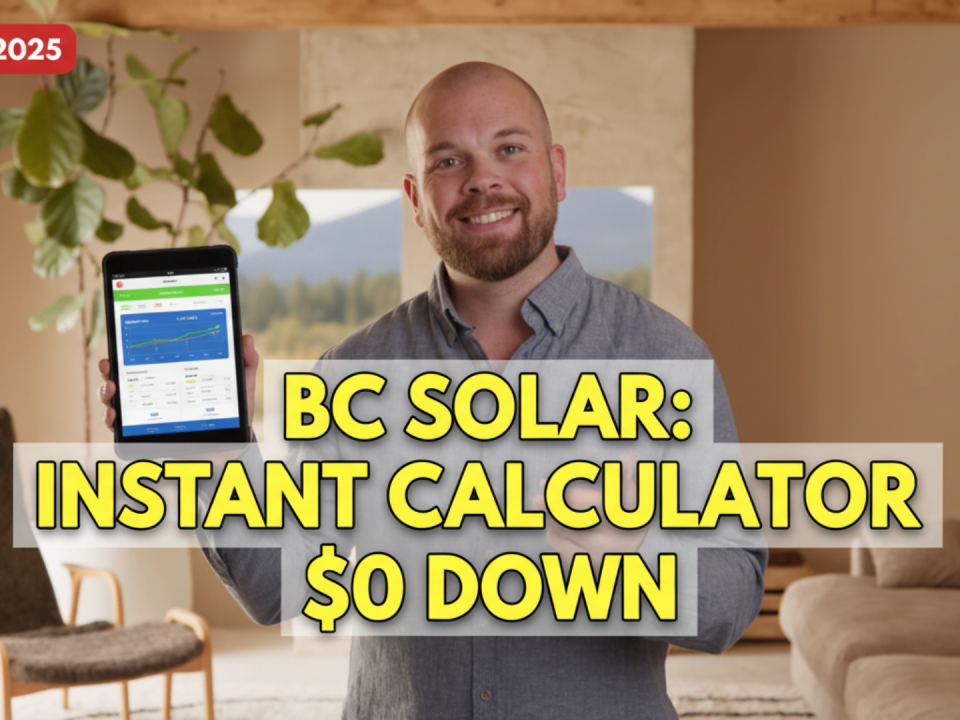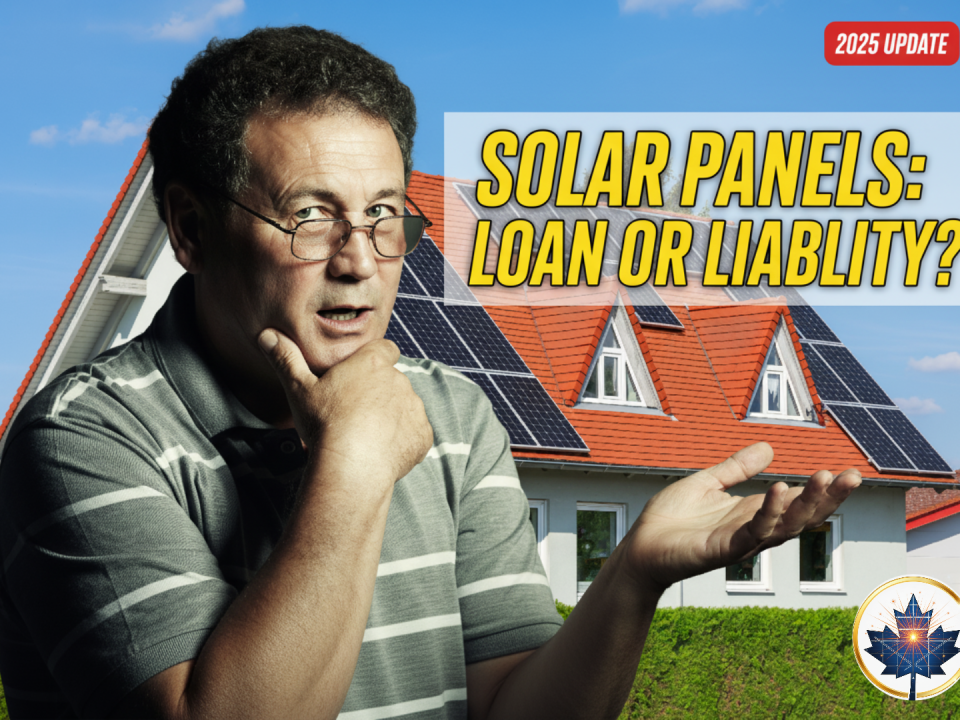
Don’t Get Burned: 15 Solar Panel Myths Canadians Still Believe in 2025
September 9, 2025
The Hidden Costs of Going Solar in Nova Scotia and Who Is Paying After You Receive a Quote
September 11, 2025You’re wondering if solar panels in Canada are a smart financial move or just a feel-good project for your roof. The short answer is: it completely depends on where you live. Your postal code is the single biggest factor determining if you’ll break even in 8 years or 25.
The Big Picture: What Are You Really Paying For?
First, let’s talk about the initial hit to your wallet. The cost of a residential solar system in Canada typically falls between $2.40 to $3.50 per watt installed. For an average-sized home needing a 7.5 kW system, the price for a complete solar system is around $18,000 to $26,000 before any incentives. For a precise estimate, it’s best to use a solar panels calculator to run the numbers for your specific home.

This price tag covers:
- The solar panels themselves.
- The inverter, which converts the sun’s DC power into AC power for your home.
- Racking and mounting equipment.
- Professional installation, wiring, and permits.
That’s a serious investment, but it’s one that can potentially eliminate most of your electricity bill for the next 25+ years. The key is figuring out how quickly you can earn that money back by saving on your electricity bill.
Federal Help: The Money Everyone Can Get
Before we dive into the provinces, know that how the Canadian government invests in solar power offers a significant boost. The main program is the Canada Greener Homes Loan. This isn’t a grant, but it’s the next best thing: an interest-free loan of up to $40,000 with a 10-year repayment term. This program makes the upfront cost much easier to handle, as you can use your monthly energy savings to pay off the loan.
Tip for Homeowners: The Greener Homes Loan requires a pre- and post-retrofit EnerGuide evaluation. Don’t skip this. It not only qualifies you for the loan but also gives you a clear picture of your home’s overall energy efficiency.
Province-by-Province Smackdown: Who’s The Real Solar King?
This is where the real story is. A province’s solar friendliness comes down to three things: how much sun it gets, its electricity rates, and available incentives. Rates are often highest in provinces relying on fossil fuels and lowest where massive hydro dams provide cheap power. High electricity rates are actually a good thing for solar owners—the more you pay for power, the more you save by generating your own.
Here’s my rating for each province, based on my experience and the current data.
| Province | Grade | Avg. Payback Period | Key Factor(s) |
|---|---|---|---|
| Nova Scotia | A | 8-12 Years | Highest electricity rates in Canada. |
| Prince Edward Island | A- | 9-13 Years | Very high electricity rates. |
| Alberta | B+ | 8-12 Years | Excellent sunshine, high electricity rates. |
| Saskatchewan | B | 9-14 Years | Best solar potential in the country. |
| Ontario | B- | 12-16 Years | High electricity rates, but fewer incentives. |
| New Brunswick | C+ | 12-16 Years | Moderate rates and incentives. |
| British Columbia | C | 15-20 Years | Great rebates, but low hydro rates. |
| Newfoundland & Lab. | C- | 16-22 Years | Lower sun exposure, moderate rates. |
| Manitoba | D | 20+ Years | Excellent incentives, but rock-bottom electricity prices. |
| Quebec | D | 20+ Years | Abundant sun, but the lowest electricity rates. |
The Top Tier: Where Solar Shines Brightest
Nova Scotia Solar Panels Guide** (Grade: A)**
- The Good: Nova Scotia has some of the highest electricity rates in the country, hovering around 18.3 ¢/kWh. This means every kilowatt-hour your panels produce delivers huge savings. The province also offers rebates for solar in Nova Scotia.
- The Pain Point: The upfront cost is still a hurdle, but the fast payback period makes it one of the best financial cases in Canada.
- The Numbers: Expect a payback period of 8 to 12 years.
Prince Edward Island Solar Panels Guide** (Grade: A-)**
- The Good: Just like its maritime neighbour, PEI has very high electricity rates (around 18.4 ¢/kWh). Strong government support and net metering policies make it an attractive place for solar.
- The Pain Point: It’s a smaller market, and with the PEI solar rebate program now closed, the upfront cost is higher.
- The Numbers: A solid 9 to 13-year payback is typical.
The Strong Contenders: Good Sun, Good Sense
Alberta Solar Panels Guide** (Grade: B+)**
- The Good: Alberta is one of Canada’s sunniest provinces. Combine that with high electricity rates (currently averaging over 25 ¢/kWh), and the savings add up fast. Many municipalities like Edmonton offer their own local rebates.
- The Pain Point: The former provincial rebate program is gone, so you’re relying on federal and municipal programs for help.
- The Numbers: Thanks to the sun and high rates, payback can be as quick as 8 to 12 years.
Saskatchewan Solar Panels Guide** (Grade: B)**
- The Good: According to Natural Resources Canada, Saskatchewan has the best solar potential in the entire country. The sun hours here are unmatched.
- The Pain Point: Electricity rates are moderate (around 19.9 ¢/kWh), which slightly extends the payback period compared to Alberta.
- The Numbers: You’re looking at a 9 to 14-year return on investment.
Ontario Solar Panels Guide** (Grade: B-)**
- The Good: With electricity rates around 14.1 ¢/kWh (and often higher with delivery fees and time-of-use pricing), the savings potential in Ontario is strong.
- The Pain Point: The generous feed-in-tariff programs of the past are long gone. The financial case isn’t the slam dunk it once was, but it’s still solid.
- The Numbers: Expect a payback period of 12 to 16 years.
The Middle of the Pack: It Can Work, But Do the Math
British Columbia Solar Panels Guide** (Grade: C)**
- The Good: BC has excellent rebates. Through the BC Hydro and FortisBC programs, you can get thousands back for your system.
- The Pain Point: The province runs on cheap, clean hydroelectricity. At around 11.4 ¢/kWh, the low electricity rate is the single biggest barrier to a quick payback.
- The Numbers: The payback period is longer, typically 15 to 20 years. It’s more of a long-term investment here.
My Experience in BC: I recently consulted with a family in Kelowna. They loved the idea of solar and were excited about the rebates. But when we ran the numbers against their low FortisBC bill, the payback was close to 18 years. They decided to go ahead for environmental reasons and to lock in their costs for the future, but it wasn’t a quick money-maker for them. It shows just how important your local electricity rate is.
The Tough Sells: Where Solar is More About Green than Greenbacks
Manitoba** & Quebec (Grade: D)**
- The Good: Both provinces have amazing solar potential and great incentives. Efficiency Manitoba offers a rebate of up to $5,000.
- The Pain Point: Dirt-cheap electricity. With rates at 10.2 ¢/kWh in Manitoba and a jaw-droppingly low 7.8 ¢/kWh in Quebec, there are hardly any savings to be had. It’s almost impossible for solar to compete financially with massive hydro dams.
- The Numbers: The payback period often exceeds 20 to 25 years, which is close to the lifespan of the panels themselves. In these provinces, going solar is a choice for energy independence and the environment, not for your wallet.
Real-World Headaches (And How to Handle Them)
Beyond the provincial differences, there are a few universal challenges.
- Net Metering vs. Net Billing: These terms sound similar but are critically different. With net metering, you get a one-for-one credit for every kWh you send back to the grid. With net billing, the utility might buy your excess power at a lower wholesale rate. Understanding if you can sell electricity back to the grid in Canada is crucial.
- Finding a Good Installer: The quality of the installation is just as important as the quality of the panels. A poorly installed system will underperform. Be sure to ask solar companies the right questions and watch out for common solar panel scams.
- Winter and Snow: Yes, panels still work in the cold. That’s just one of the many solar panel myths Canadians still believe. However, a thick layer of snow can stop production completely. A good angled installation helps snow slide off, but a heavy dump might require you to clear them.
- Navigating the Paperwork: Between municipal permits, provincial rebate applications, and federal loan documentation, the paperwork can be a headache. A good installer will handle most of this for you, but it’s a key factor to ask about in your initial quotes.
The Bottom Line: Is It Worth It for YOU?
So, do solar panels pay for themselves in Canada?
- In Nova Scotia, PEI, Alberta, and Saskatchewan, the financial case is strong. The payback is reasonable, and you’ll enjoy over a decade of free electricity.
- In Ontario and New Brunswick, it’s a solid long-term investment that will protect you from rising electricity costs.
- In British Columbia, the generous rebates help, but be prepared for a long wait to break even.
- In Manitoba and Quebec, it’s tough to justify on cost alone. It’s a decision driven by environmental values.
Ultimately, the choice is yours. The best first step is to get a personalized estimate with a solar panel cost calculator. From there, you can get multiple quotes and take control of your energy future. Instead of just paying a bill, you’ll be making a powerful investment in your home’s value and stability.




